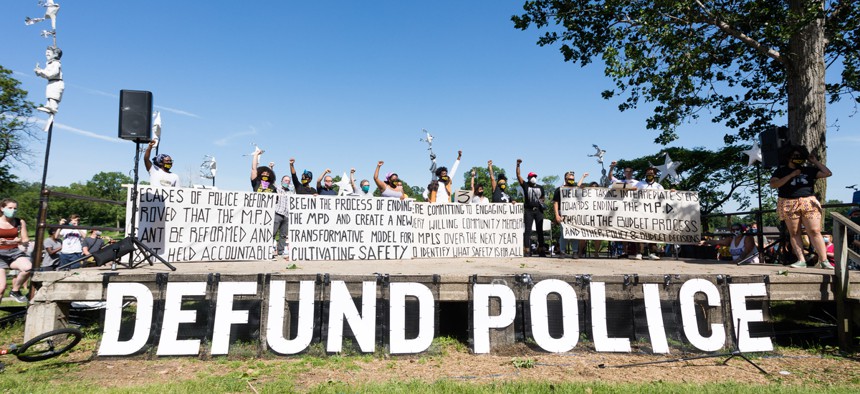Instead of Defunding Police, Minneapolis Cuts $8 Million from Department Budget

Activists call for defunding the police at a protest in Minneapolis in June. Shutterstock
After the police killing of George Floyd, a majority of the city council vowed to dismantle the police department. They took a much more modest step this week.
The Minneapolis City Council voted on Thursday to cut nearly $8 million from the city’s police department and move those dollars to violence prevention, mental health crisis response teams, and other city services. The plan marks the latest police reform effort in the city that was rocked in May by the police killing of George Floyd and the subsequent protests that lasted for months and frequently called for the far more sweeping idea of “defunding the police.”
The cuts from the proposed budget of $179 million would not affect staffing levels in the department, something that Mayor Jacob Frey said would cause him to veto any plan that crossed his desk. An earlier plan before the council would have reduced the cap on the number of officers in the city from 888 to 750 starting in 2022, an idea Frey called “irresponsible.”
“We all share a deep and abiding reverence for the role our local government plays in service of the people of our city,” Frey said. “The additional funding for new public safety solutions will also allow the city to continue upscaling important mental health, non-police response, and social service components in our emergency response system.”
Council member Steve Fletcher, who co-authored the proposal to lower the staffing cap, said that the council “passed a budget that represents a compromise, and also a big step forward into a more compassionate and effective public safety future.” He also said that more work lies ahead of the city council, and that they “cannot afford to remain stuck in the past any longer.”
City residents are split on their opinion of the plan’s cuts. More than 300 people signed up to speak at the council meeting about the plan. Some residents said cutting police funding during a crime surge and at a time when officers are leaving the city’s department in droves could make neighborhoods more dangerous. To date, murders in Minneapolis are up 77% this year over last year, following a trend also seen in most major cities.
But other residents said the city council isn’t taking community concerns seriously and that council members who vowed to fundamentally remake the police department have gone back on their word. Will Roberts, a city resident who grew up in the Longfellow neighborhood where the Third Precinct was burned after Floyd’s killing, told council members that “the place I grew up this summer burned … and it burned because of police misconduct.”
In June, a majority of the city council vowed to disband the police department and replace it with a “Department of Community Safety and Violence Prevention.” The proposal would have reinvested the police budget in community-led public safety programs, part of a broader national call from community activists to defund law enforcement departments and reimagine public safety as a strong social safety net. The millions spent on policing, activists argue, could be put to better use by investing in programs like violence interruption efforts, homeless housing, community health centers, early childhood education initiatives, and crisis response teams composed of social workers.
Frey was not supportive of that proposal and said he would work for reform instead of defunding. A poll taken by local news outlets over the summer found that a majority of people supported redirecting some money from the police, but found respondents sharply divided on reducing the numbers of officers. Black respondents were less likely to back the idea of a smaller department.
Some city council members backtracked on the idea in later months and major disbanding efforts stalled. Minneapolis ended up taking a policy approach that looks very similar to what other cities have done in the past few months: banning chokeholds, revising the use-of-force policy and changing procedures around when crowd control weapons like rubber bullets, tear gas, and flash-bang grenades can be used.
These procedural changes were made as part of a civil rights investigation led by the Minnesota Department of Human Rights, which pushed for a state-led consent decree following Floyd’s death to ensure reform in the city’s police department. (The Minnesota department has said that they’re interested in partnering with the U.S. Department of Justice should an incoming Biden administration reinstate federal pattern and practice investigations.)
The city’s new “Safety for All Budget Plan” is geared toward adding to these efforts by providing additional funding for the city’s Office of Police Conduct Review, housed in the city’s Civil Rights Department, which is tasked with investigating complaints about police officer behavior. The funding shifts will also include $2.4 million to launch a non-police 911 mental health response team and $2 million to expand violence prevention programs. The funding comes primarily from the police department’s overtime budget.
Council President Lisa Bender said that the council has been “working together to respond to complex demands from a community reeling from police violence, community violence, [and] social unrest” and came to “common sense” solutions. “In the first budget since George Floyd’s death at the hands of Minneapolis police, the City Council has adopted a budget that invests in specific, concrete actions to transform community safety starting in 2021,” she said.
The plan received the support of organizations like the Minnesota ACLU, which called it “a meaningful step toward a future that values prevention over punishment and centers the safety and well-being of all communities, not just wealthy white ones.”
Emma Coleman is the assistant editor for Route Fifty.
NEXT STORY: The Danger of Assuming That Family Time Is Dispensable






